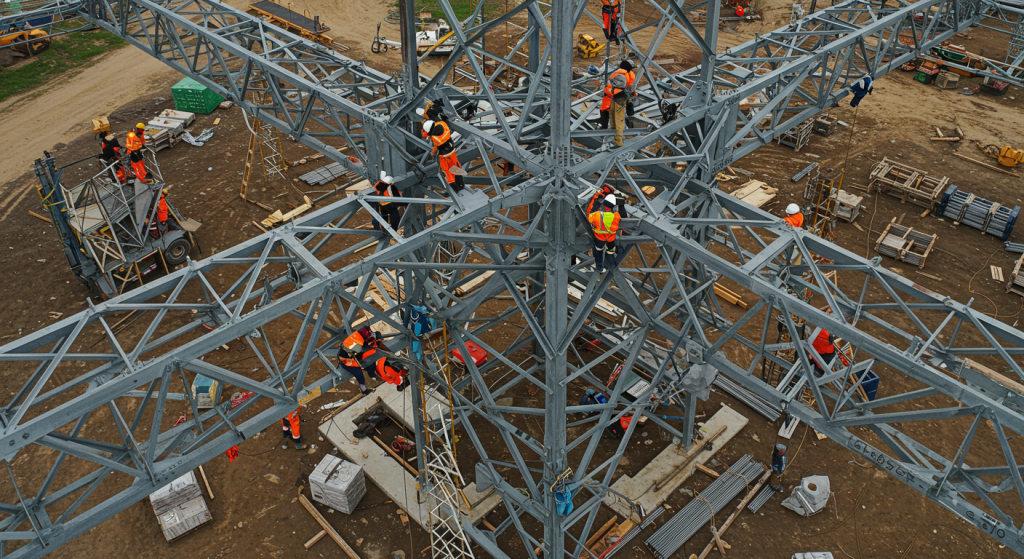Electric Tower Construction: Types, Process & Technology
2025-04-23
Introduction to Electric Tower
The construction of electricity towers facilitates the transmission and distribution of electric power, serving as the main framework of the power transmission network. It enables efficient electricity transport. It extends from power plants to substations and finally to the consumers. Due to the transformation in energy technologies and the increasing demand for electric energy, constructing reliable transmission towers has become an utmost priority.
Understanding Electric Tower Construction
Electric tower construction, or electronic pylon construction, is the process of designing, fabricating, and erecting tall structures that serve the purpose of supporting overhead power lines. Power pylons are built to resist and endure tough environments, mechanical loads, and even electrical stresses.
• Construction Purpose: Electric towers serve the purpose of providing overall support and maintaining appropriate tension to overhead transmission lines.
• Voltage Intake / Capacity: The construction purpose of Electric Girders is to be utilized in the fields of Utilities and/or civil works for High voltage and Extra high voltage from 110KV to 765KV
Types of Electric Towers
Different kinds of electric towers perform different functions in the transmission network. Knowing what each type does is important in deciding which tower to use for which application.
• Lattice Towers: These are economical for longer spans since they are constructed using steel angle sections.
• Monopole Towers: Ideal for urban areas since they are tubular and space-saving.
• Guyed Towers: Economical for specific layouts and are stabilized with guy wires.
• Self-Supporting Towers: Suitable for rugged terrains as they are heavy-duty, freestanding towers.
• Suspension Towers: Change direction as they carry conductors.
• Angle Towers: Used when there are changes in directional turns for the transmission line.
Site Preparation and Project Management
A well-thought-out plan with preparation lays a successful groundwork for any electric tower project.
• Site Selection: Considers environment, topography, and general access.
• Surveying & Mapping: Integration for tower and road alignment relative to placement for pre-planned use.
• Wayleave Management: Legal land permission acquisition.
• Soil Testing: Determines the foundation type best suited.
• Environmental Assessment: Assess compliance with regional bylaws.
Tower Foundation Design and Construction
A transmission tower comes into existence from its foundation.
• Foundation Types: Pad & chimney or raft type, depending on the soil overburden, along with pile or grillage.
• Load Calculations: Vertical and wind forces with tension from conductors must be factored in.
• Material Use: Construction will require concrete, applied steel, anchor bolts, and anti-corrosive covering.
• Optimal Strength: Maximum Strength can be obtained after curing for 14-28 days.

Assembly and Erection
Tower Erection is a multi-step approach with a focus on precision and safety.
• Prefabrication: The fabrication of tower sections takes place using bolts or welded connections.
• Transport: In remote areas, the components can be delivered using a helicopter, and a truck in more accessible areas.
• Assembly: Bolting or riveting is done at the site using cranes and other lifting machines.
• Erection: Heavy lifts usually require the rental of a crane.
• Alignment and Contriving: Check that the structure is level and true before stringing.
Stringing with Other Electrical Work
Stringing the transmission lines is executed after the finishing touches are added to the tower structure.
• Types of Conductors: Depending on the current capacity, the conductors can be ACSR, AAAC, or ACCC.
• Insulators and Other Parts: These can be glass, porcelain, or composite insulators that perform the duty of electrically separating components.
• Stringing Methods: This can be performed manually, semi-autonomously, or using a helicopter.
• Tensioning: Tools designated for precision are used to ensure that constant tension is applied.
Standards of Compliance and Safety
These construction procedures pose a high risk and put safety concerns over anything else.
• Construction safety: In the Electric tower construction, these include head aids, PPE, scaffolds, and equipment to protect against falls.
• Working at altitude: This is another term for requiring specialized equipment and training.
• Regulatory Standards: Elaboration of working under IS802 and IEC guidelines.
• Training and Certification: Personnel working under high-voltage construction are required to be certified in these activities.
What Type of Materials are Used in Tower Construction?
The strength and longevity of transmission towers depend on high-quality materials.
• Steel Grades: Galvanized steel with a yield strength of 450 MPa.
• Angle Sections: Standard dimensions according to the load calculations.
• Crossarms: Load and voltage requirements are made with precision fabrication.
• Fasteners: Bolted and washed connections of high strength.
Timeline and Challenges in Electric Tower Construction
Each Electric tower construction project has a defined timeline depending on the scope and external parameters such as location.
• Average Duration: 3-6 months from planning to commissioning.
• Common Challenges: Meteorological factors, terrain access, material availability, and regulatory requirements.
• Risk Mitigation: Aggressive planning, contingency budgeting, and stakeholder engagement.
Best Construction Techniques for Electric Towers
• Conduct a detailed site inspection.
• Implement modular designs for easier and faster assembly.
• Focus on safety equipment and safety training.
• Use smart technologies to assist with maintenance routines.
• Use materials that are less likely to corrode.
Electric Tower Lifecycle: Maintenance and Monitoring
- Inspections: Visual inspections and drone inspections.
- Structural Health Monitoring (SHM): Sensors for monitoring stress and fatigue.
- Maintenance: Adjusting tension, replacing insulators, etc.
- Decommissioning: Safe removal of obsolete towers.
What Makes XY Tower Different in Electric Tower Construction?
At XY Tower, we provide complete services in electric tower construction, including designing, manufacturing, installing, and maintaining towers. With our state-of-the-art manufacturing equipment, top quality is assured, along with outstanding engineering skills and efficiency during all projects. Our services include, but are not limited to:
- Custom designing monopole and lattice towers
- Providing an entire EPC package
- Full adherence to international requirements
- Environmentally friendly and low-cost options
Take a look at the towers we manufacture and see for yourself how advanced we are in the industry.
Conclusion
The erection of electric towers involves meticulous planning while simultaneously considering legal guidelines. These towers are now far more advanced in their design, materials, and techniques, making them more efficient and environmentally friendly than in previous years. To learn more about how XY Tower leads the way in electric tower manufacturing and construction, visit our official website.

Hey, I’m Chunjian Shu
"X.Y. Tower: Reliable, innovative solutions for high-quality towers and electrical equipment with professional service.
